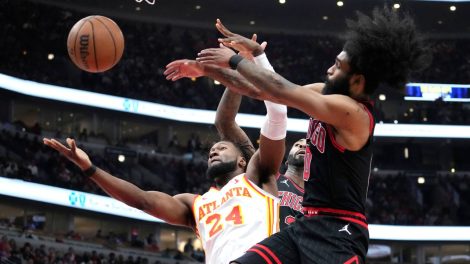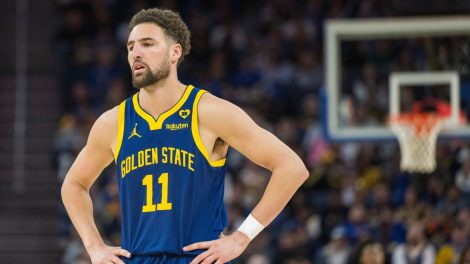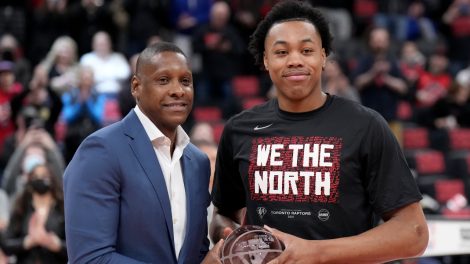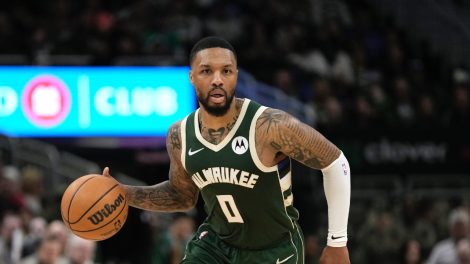TORONTO — The Toronto Raptors are currently in the midst of nearly 72 hours off between Saturday’s 97-83 defeat to the Milwaukee Bucks and Tuesday’s opportunity to avenge it. That’s a lot of time. And it sounds like Raptors head coach Dwane Casey has spent much of it replaying his team’s shortcomings during that opening-game loss over and over and over again.
"You can look at the film and know exactly what we did and didn’t do," Casey said. "It doesn’t take a rocket scientist—if you know anything about basketball—to look at the film, and understand the areas that we did not accomplish."
For Casey, that starts with pure hustle. The Raptors held a less-than-positive film session Sunday, with Casey and his staff hammering home examples of their players not hurrying back on defence, not committing to their scramble rotations and, most frustratingly for the coaches, simply getting out-worked.
"Whether it was making multiple efforts, scrambling, next guy rotating—we didn’t do it," Casey said, noting that the Raptors gave up 28 points in transition, 17 fast-break points, and 40 in the paint. "We can’t give up those type of sweat points—easy points. Because now they’ve got their swagger. Now they’re flexing and doing all the stuff that they were doing and getting their confidence level up—and now everything’s going in. That’s the difference."
[relatedlinks]
Milwaukee’s the best team in basketball when it comes to scoring in the paint, partially because they get there so quickly. Any miss you make or ball you cough up in Milwaukee’s end is quickly turned around, transitioned up the floor, and under your own basket in a matter of seconds. While they’re young and relatively unproven, no one can doubt the sheer inertia the Bucks generate as they sprint up the court.
The Raptors plan to counter that in Game 1 was to stay away from the offensive glass and focus on taking a positive first three steps back towards their own end whenever the ball changed hands around Milwaukee’s basket. That didn’t happen. But they’ll try again in Game 2, and you’ll know how well it’s going by the number of times Casey has his hands on his head after a Raptors wing crashes the offensive paint or one of his players gets knocked down and doesn’t get back up and in the play quickly enough.
"To win in this league we’ve got to play at another level," Casey says. "You can’t play at regular-season level. You’ve got to screen in playoff form, you’ve got to cut in playoff form, you’ve got to turn in playoff form. And we didn’t do that long enough in Game 1. We did it in certain parts of the game. But not long enough."
There is also the issue of Giannis Antetokounmpo, the designed-in-a-basketball-lab superhuman who unsurprisingly gave the Raptors fits Saturday. It’s folly to think you can ever truly contain a player like Antetokounmpo. He’s too big, too athletic, too talented. He’s getting his points in every game of this series, one way or another.
What the Raptors want to do is control where those points come from. If they can keep Antetokounmpo away from the paint, and hinder his ability to drive, they can at least limit his effectiveness.
"We got to shut the paint down. Paint is number one. The paint is gold in this series," says Raptors guard P.J. Tucker. "He’s going to try to get to the paint. We’re going to try to give him the shot, and he’s not going to take it. He’s going to keep trying to get to the paint. So, for us, its defending the paint."
The Raptors will also look to simply slow Antetokounmpo down by getting in his way, playing physical with him, and making him work to earn his space. Every Raptor is aware Antetokounmpo had it way too easy in Game 1, streaking up the court untouched in transition and finding plenty of open court as he darted around screens.
One possible solution Casey has publicly raised is injecting the youthful Norman Powell or Delon Wright into the rotation at times in order to simply raise the Raptors’ energy levels and disrupt Milwaukee’s gameflow. There won’t be many minutes dedicated to that role—but if Powell or Wright find themselves in it, they’ll be asked to shrink the court, get their body in front of Antetokounmpo whether he has the ball or not, and, as Casey puts it, "agitate a little bit."
Another crucial area in Game 2 will be how the Raptors organize their defence quickly when facing the pressure of Milwaukee’s blitzing transition game. Making life difficult for Antetokounmpo is one thing; not forgetting about his teammates is another. The Raptors struggled to adjust defensively in Game 1, especially when Milwaukee pressured them and raised the tempo.
"The communication has to be a lot better," Tucker says. "We’ve gotta talk and figure out certain situations—what we want to do, who we want to send over for a double team, who we don’t want to switch on. I don’t think people realize how hard it is to communicate and how hard it is to get onto the next play while having to run on the break and run the offence and think about what you’re going to do when you get back on defence. It’s all on the fly, it all happens fast. But it’s just communication."
Those will be focuses for the Raptors when they tip off Game 2 on Tuesday night. A couple hours after that, Casey will have a new stretch of film to pore over. He hopes it won’t be quite as glaring as Game 1’s.
"This has been a resilient team. For whatever reason, we’re better with our backs against the wall," Casey said. "We just have to come out and do it tomorrow night."









